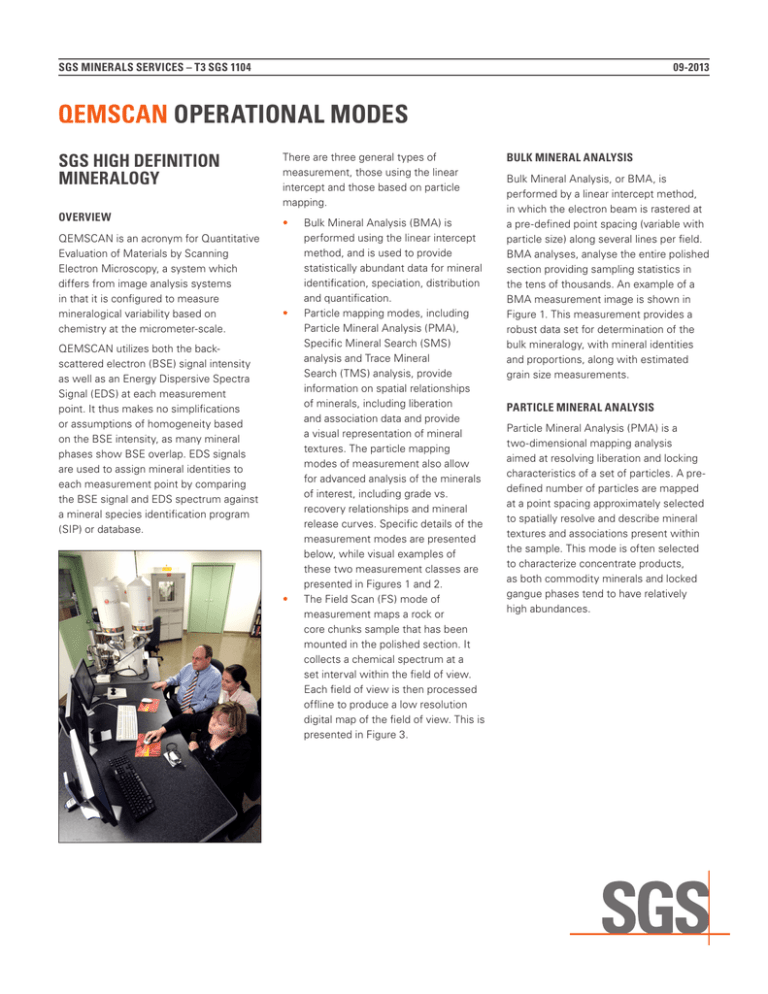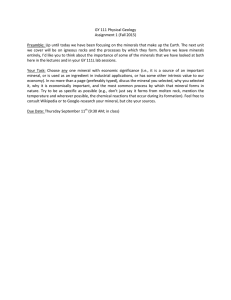
SGS MINERALS SERVICES – T3 SGS 1104
09-2013
QEMSCAN OPERATIONAL MODES
SGS HIGH DEFINITION
MINERALOGY
OVERVIEW
QEMSCAN is an acronym for Quantitative
Evaluation of Materials by Scanning
Electron Microscopy, a system which
differs from image analysis systems
in that it is configured to measure
mineralogical variability based on
chemistry at the micrometer-scale.
There are three general types of
measurement, those using the linear
intercept and those based on particle
mapping.
••
••
QEMSCAN utilizes both the backscattered electron (BSE) signal intensity
as well as an Energy Dispersive Spectra
Signal (EDS) at each measurement
point. It thus makes no simplifications
or assumptions of homogeneity based
on the BSE intensity, as many mineral
phases show BSE overlap. EDS signals
are used to assign mineral identities to
each measurement point by comparing
the BSE signal and EDS spectrum against
a mineral species identification program
(SIP) or database.
••
Bulk Mineral Analysis (BMA) is
performed using the linear intercept
method, and is used to provide
statistically abundant data for mineral
identification, speciation, distribution
and quantification.
Particle mapping modes, including
Particle Mineral Analysis (PMA),
Specific Mineral Search (SMS)
analysis and Trace Mineral
Search (TMS) analysis, provide
information on spatial relationships
of minerals, including liberation
and association data and provide
a visual representation of mineral
textures. The particle mapping
modes of measurement also allow
for advanced analysis of the minerals
of interest, including grade vs.
recovery relationships and mineral
release curves. Specific details of the
measurement modes are presented
below, while visual examples of
these two measurement classes are
presented in Figures 1 and 2.
The Field Scan (FS) mode of
measurement maps a rock or
core chunks sample that has been
mounted in the polished section. It
collects a chemical spectrum at a
set interval within the field of view.
Each field of view is then processed
offline to produce a low resolution
digital map of the field of view. This is
presented in Figure 3.
BULK MINERAL ANALYSIS
Bulk Mineral Analysis, or BMA, is
performed by a linear intercept method,
in which the electron beam is rastered at
a pre-defined point spacing (variable with
particle size) along several lines per field.
BMA analyses, analyse the entire polished
section providing sampling statistics in
the tens of thousands. An example of a
BMA measurement image is shown in
Figure 1. This measurement provides a
robust data set for determination of the
bulk mineralogy, with mineral identities
and proportions, along with estimated
grain size measurements.
PARTICLE MINERAL ANALYSIS
Particle Mineral Analysis (PMA) is a
two-dimensional mapping analysis
aimed at resolving liberation and locking
characteristics of a set of particles. A predefined number of particles are mapped
at a point spacing approximately selected
to spatially resolve and describe mineral
textures and associations present within
the sample. This mode is often selected
to characterize concentrate products,
as both commodity minerals and locked
gangue phases tend to have relatively
high abundances.
SGS MINERALS SERVICES – T3 SGS 1104
2
SPECIFIC MINERAL SEARCH
Specific Mineral Search, or SMS, is a
particle analysis method, which only
analyses a pre-determined subpopulation
of the particles present. The packages
are based on the premise that the target
phases have a
higher back-scattered electron brightness
than the bulk of the gangue phases.
This enables each block to be scanned for
particles containing the target phase(s),
and only those that are brighter are fully
analysed. As the entire block is scanned,
this also produces the highest possible
statistical population for the trace phase.
This mode of measurement would be
most appropriate for ores of low sulphide
grade, searching specifically for particles
containing sulphide minerals.
Figure 1. BMA Measurement Mode
TRACE MINERAL SEARCH
Trace Mineral Search (TMS) is an
additional mapping routine, where a phase
constituent and can be located by
thresholding of the back-scattered
electron intensity. The objective of this
routine is to reject barren fields and
increase analysis efficiency. The outputs
are otherwise identical to the SMS
routine. This mode of measurement
is often used for advanced studies of
gold and PGE ores, or trace minerals of
interest such as molybdenite.
It is important to note that SMS and TMS
results pertain only to the target minerals.
PMA must be selected if quantitative
gangue characterization is required. That
is, the analysis modes are designed to
analyse only the target-bearing subpopulation, and the results therefore do
not reflect the bulk mineralogy of the
overall sample. As a result, these target
search studies are commonly paired
with BMA analyses to provide bulk
mineralogical context to the SMS/TMS
results.
Figure 2. Particle Mapping (PMA, SMS or TMS) Measurement Mode
SGS MINERALS SERVICES – T3 SGS 1104
3
FIELD SCAN
The Field Scan (FS) mode of measurement maps a rock chip or core sample that has been mounted in the polished section. It collects a
chemical spectrum at a set interval within the field of view. Each field of view is them processed offline to generate a single integrated
image and a false-colour image of the core sample is produced.
© SGS Group Management SA – 2013 – All rights reserved - SGS is a registered trademark of SGS Group Management SA
Figure 3. Field Scan Mode of Measurement;
Image 1: Selected Core Sample
Image 2: Polished Thin Section
Image 3: QEMSCAN™ False-colour Image of the Polished Thin Section with Legend/Mineral List
CONTACT INFORMATION
Email us at minerals@sgs.com
www.sgs.com/mining


